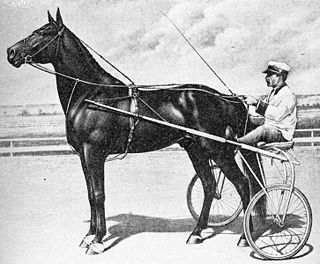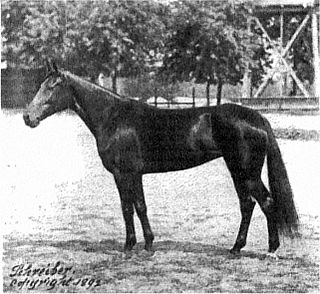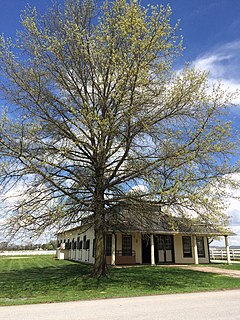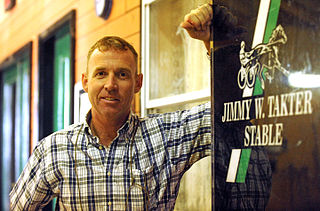
Harness racing is a form of horse racing in which the horses race at a specific gait. They usually pull a two-wheeled cart called a sulky, or spider, or chariot occupied by a driver. In Europe, and less frequently in Australia and New Zealand, races with jockeys riding directly on saddled trotters are also conducted.

Dan Patch was a noted American Standardbred pacer. At a time when harness racing was one of the largest sports in the nation, Dan Patch was a major celebrity. He was undefeated in open competition, and was so dominant on the racetrack that other owners eventually refused to enter their horses against him. Instead, he ended his racing career performing time trials, and traveled extensively on exhibition, earning millions of dollars in purses, attendance gate receipts, and product endorsements. Dan Patch broke world speed records at least 14 times in the early 1900s. In 1905, he set a world's record for the fastest mile by a harness horse that stood unmatched for over 30 years. Unofficially, Dan Patch broke this record in 1906 with a clocking of 1:55. He died on July 11, 1916. His owner, Marion Willis Savage, died just one day later.

Greyhound was a grey Standardbred gelding by Guy Abbey out of Elizabeth by Peter the Great. Born in 1932, Greyhound was the outstanding trotting horse of his day and arguably the most outstanding in the history of the sport. He was nicknamed "The Great Grey Ghost" and "Silver-skinned Flyer." In 1935, he won the Hambletonian race and in 1938 he lowered the record time for trotting the mile to 1:55¼. This record stood until 1969.
The Hambletonian Stakes is a major American harness race, named in honor of Hambletonian 10, a foundation sire of the Standardbred horse breed, also known as the "Father of the American Trotter." The Hambletonian is held annually for three-year-old trotting Standardbreds. It is the first event in the Triple Crown of Harness Racing for Trotters. The Hambletonian is run at Meadowlands Racetrack on the first Saturday in August.
Castleton Lyons near Lexington, Kentucky, is an American horse-racing stable and breeding business best known by the name Castleton Farm.

Nancy Hanks was an undefeated Standardbred trotting mare named for Abraham Lincoln's mother. She was the first 2:05 trotter in harness-racing history.

Hambletonian 10, or Rysdyk's Hambletonian, was an American trotter and a founding sire of the Standardbred horse breed. The stallion was born in Sugar Loaf, New York, on 5 May 1849. Hambletonian has been inducted into the Immortals category of the Harness Racing Hall of Fame.
Hanover's Bertha (1927-1944) was a Standardbred horse and harness racing champion bred by Alexander B. Coxe and foaled at Hanover Shoe Farms in Hanover, Pennsylvania. She won the 1930 Hambletonian Stakes at Good Time Park in Goshen, New York, as well as the Kentucky Futurity at The Red Mile in Lexington, Kentucky.

Hanover Shoe Farms, Inc. is a North American Standardbred horse breeding facilities. Its history traces back to the early 1900s.

John Duncan Campbell is a retired Canadian harness racing driver. He has been inducted into the Harness Racing Hall of Fame, the Canadian Horse Racing Hall of Fame and Canada's Sports Hall of Fame.
Breed = Standartbred , Sire = Andover Hall , Grandsire = Garland Lobell , Sex = Stallion , Foaled = 2004 , Country = United States.
Timothy A. Tetrick, born November 22, 1981, in Flora, Illinois, is an American Harness Racing driver. Tim started driving Standardbreds at a very young age and on November 27, 2007, broke the record of number of wins (1,077) in a single year. Tim drove his 1,078th winner at Dover Downs in Delaware on the way to recording 1,189 wins that year. Class of the 2020 USHWA Hall of Fame!
Nevele Pride was an American standardbred harness racehorse who set world records as fastest trotter on multiple occasions. Owned by Stanley Dancer, Nevele Pride won 57 races and was honored as Harness Horse of the Year in three consecutive years. The horse earned more than $870,000 during his racing career.

Highland Fling was a New Zealand bred Standardbred racehorse. He is notable in that he won two New Zealand Trotting Cup races, the richest harness race, and sometimes the richest horse race in New Zealand. Highland Fling was a leading performer in the years 1947 and 1948. He won the 1948 New Zealand Trotting Cup with a handicap of 60 yards.

Jimmy Takter is a harness racing horse trainer based in East Windsor, New Jersey, who came to the U.S. in 1982. He was inducted into the U.S. Harness Racing Hall of Fame in 2012.
Bruce Nickells is an American harness racing driver and trainer. Nickells was inducted into the Harness Racing Hall of Fame on July 4, 2016.
Adelbert "Del" Cameron (1920-1979) was an American harness racing driver. Cameron was voted into the Harness Racing Hall of Fame in 1974.
Michel "Mike" Lachance is a retired harness racing driver. Widely recognized as among the best drivers of all time, his outstanding career began in 1967 in Quebec City. At retirement, he had won 10,253 races and purses totalling $187,710,149. He has been inducted into both the United States and Canadian Harness Racing Halls of Fame.
Scott Frost (1952-1983) was a United States Harness Racing Hall of Fame Standardbred trotter trained and driven by future Hall of Fame inductee Joe O'Brien. His performances on the racetrack in 1954 saw him voted United States Two-Year-Old Trotter of the Year and in 1955 he became the first winner of the U.S. Trotting Triple Crown series and was voted U.S. Harness Horse of the Year. Racing at age four in 1956, Scott Frost became the first horse to twice win Harness Horse of the Year honors.
Joseph Cyril O'Brien was a Harness racing driver, trainer and owner who won the U.S. Trotting Triple Crown in 1955 and would be inducted into both the U.S. Harness Racing Hall of Fame and the Canadian Horse Racing Hall of Fame, as well as Canada's Sports Hall of Fame. Noted for his quiet dignity and diplomacy, he is considered one of the greatest harness horsemen in history.











